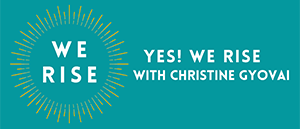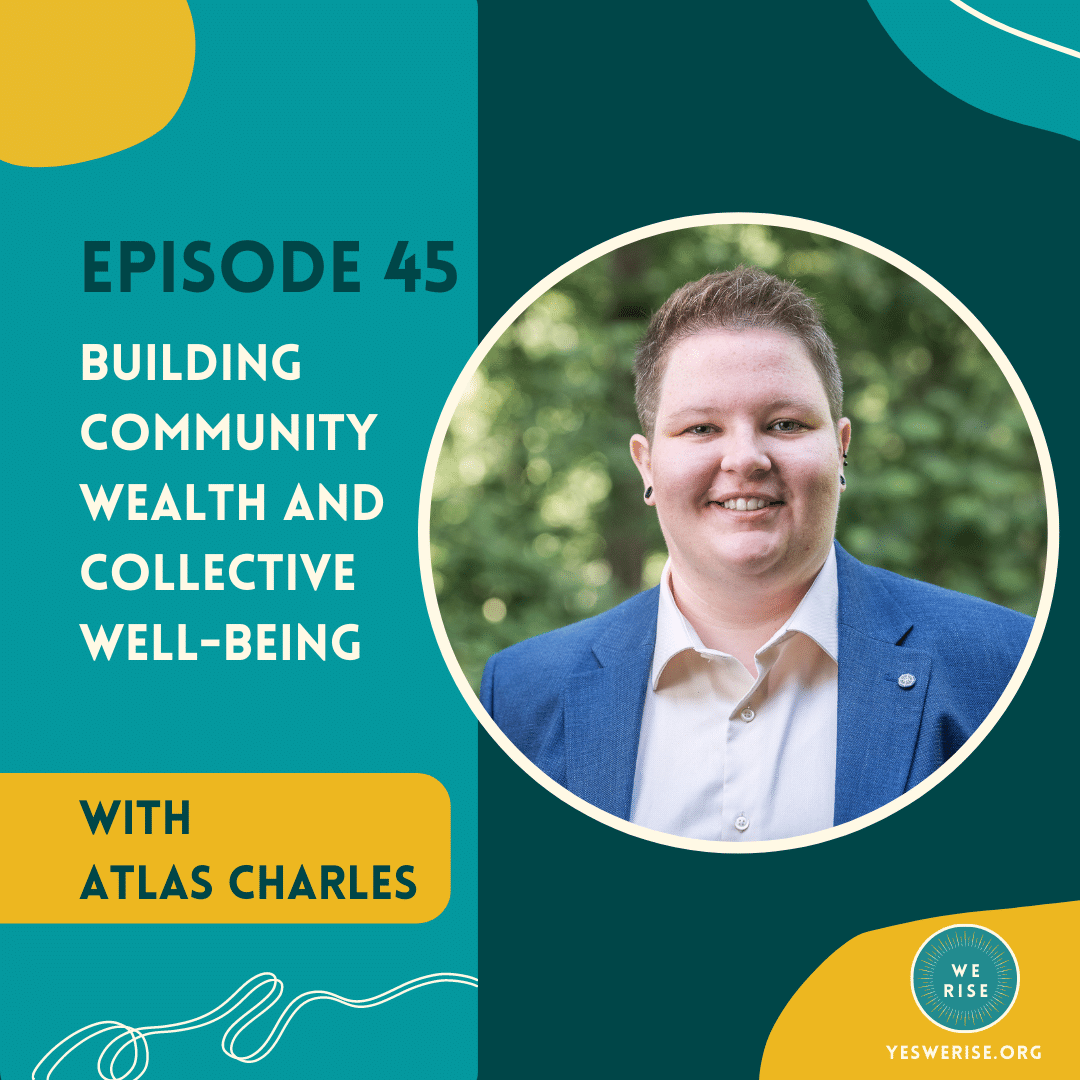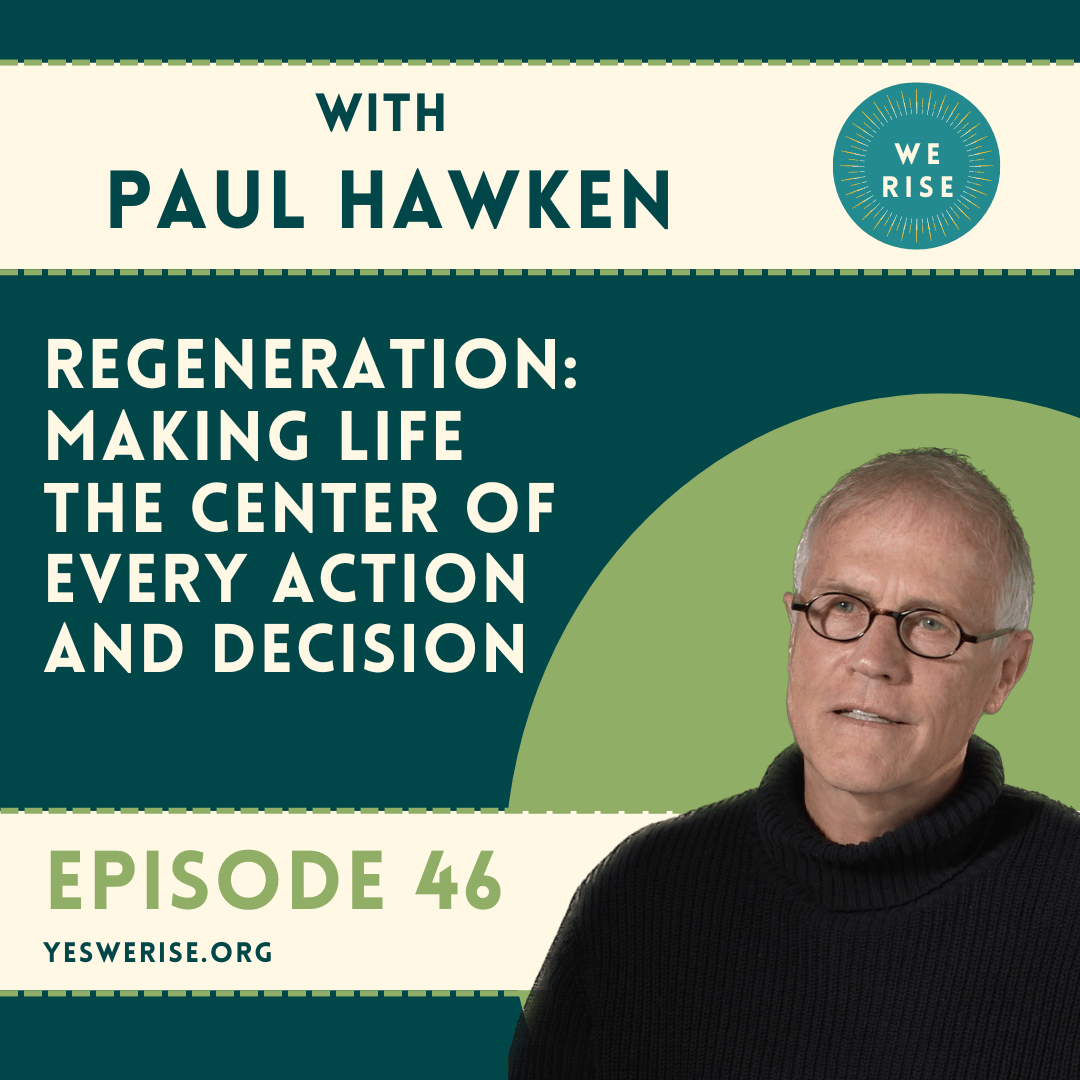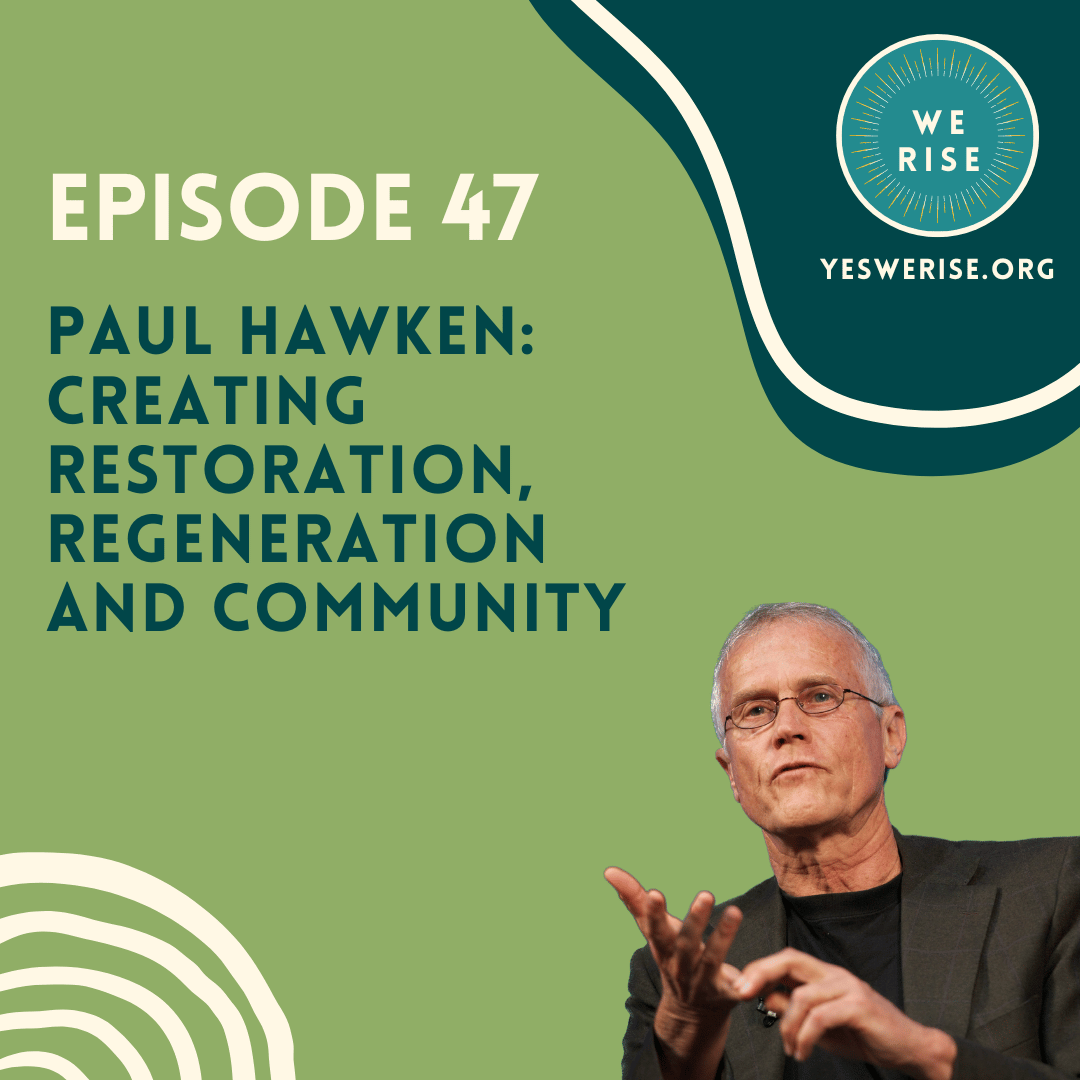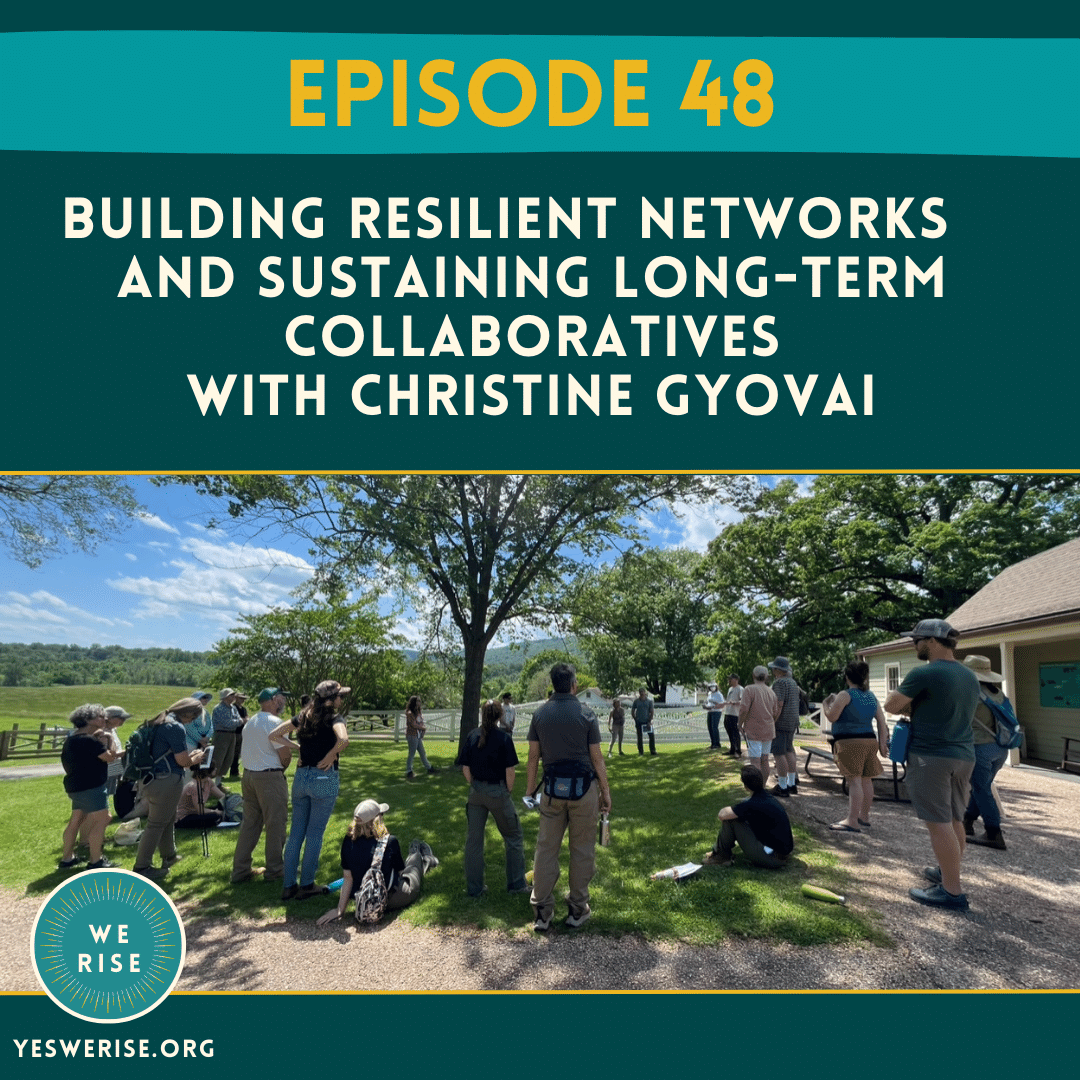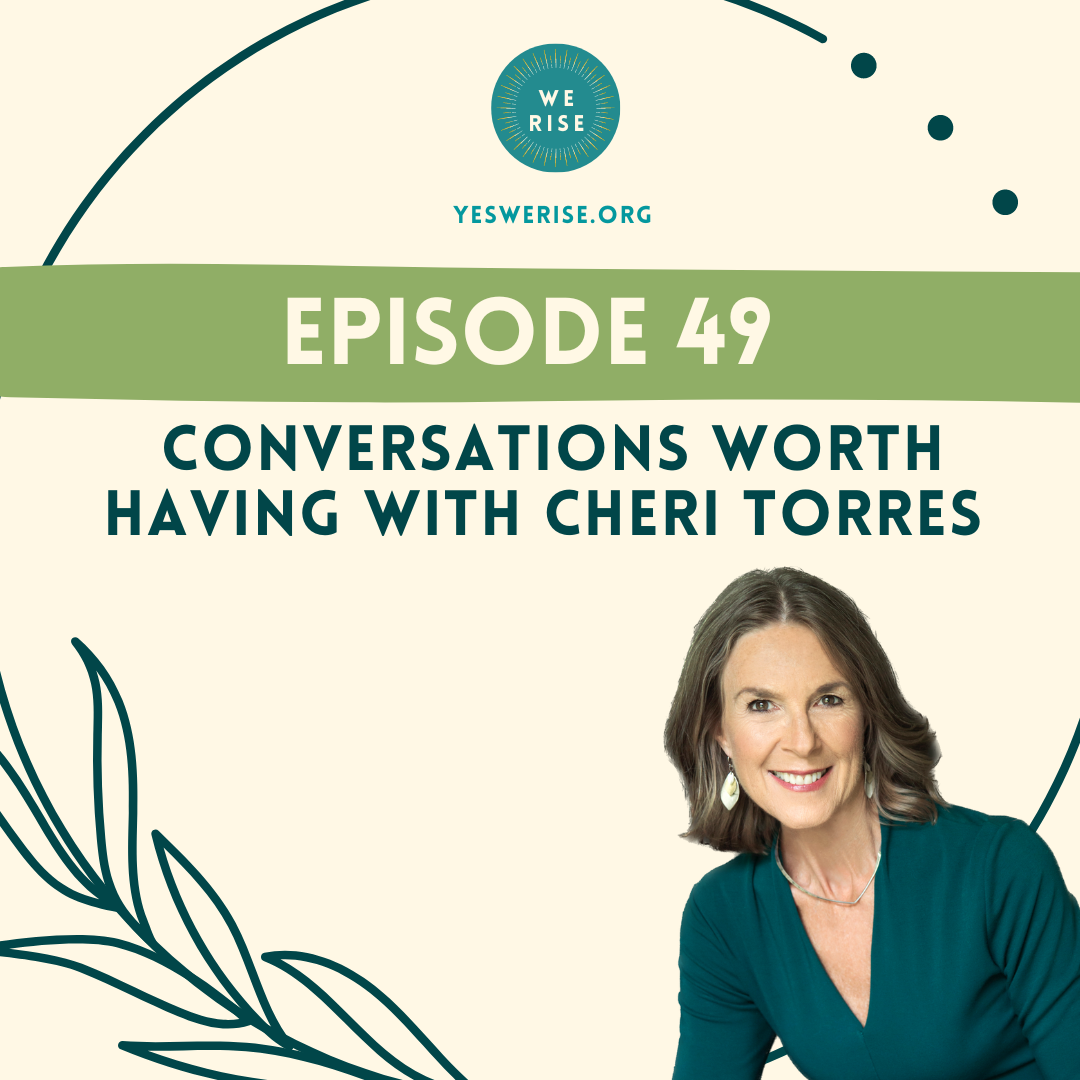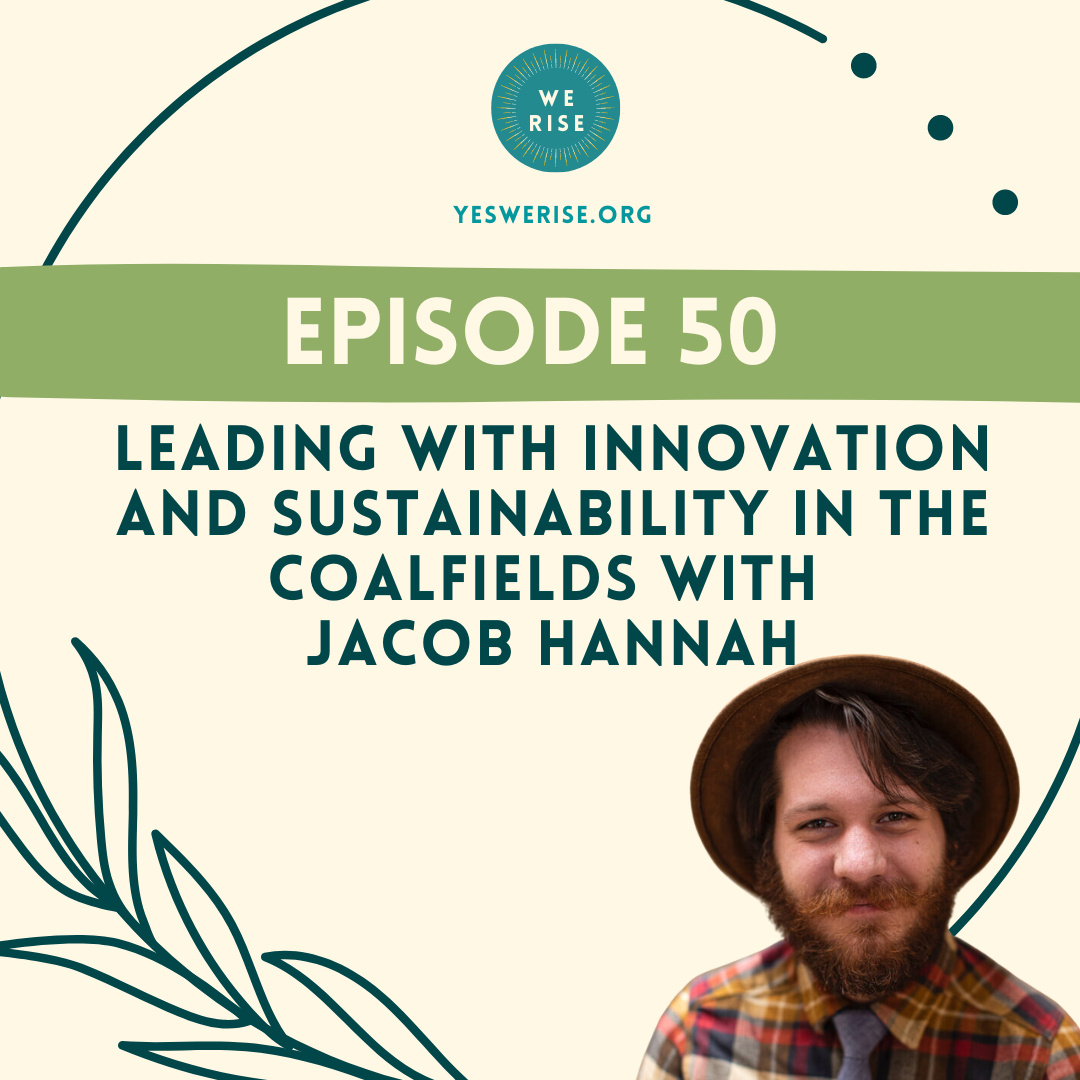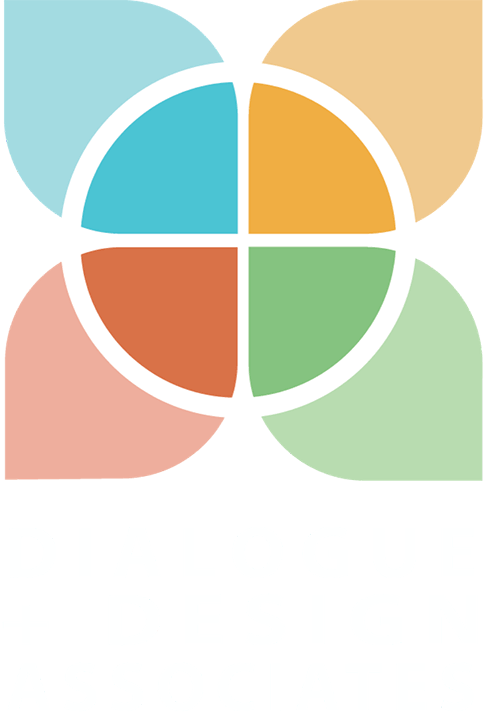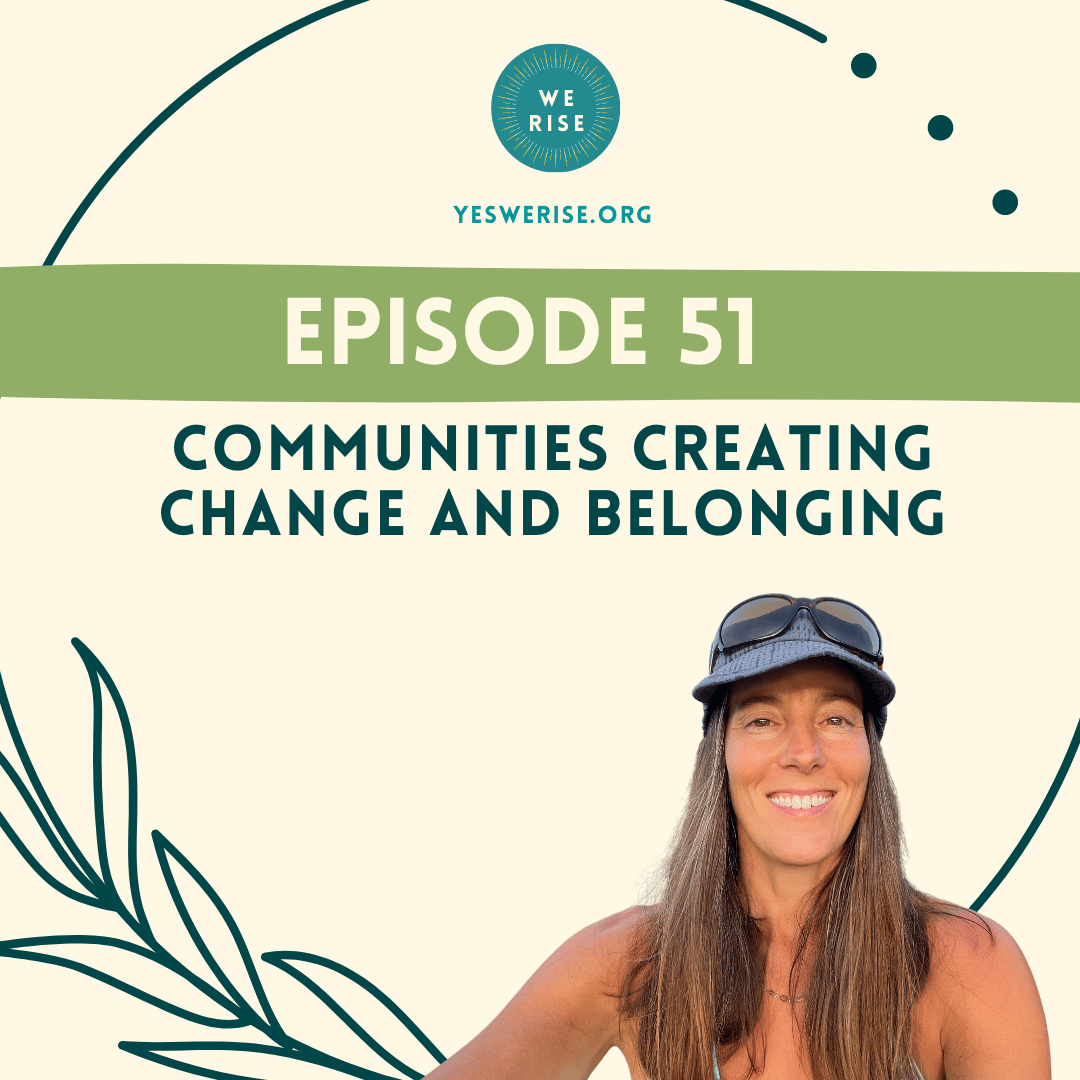
Episode 51:
Communities Creating Change and Belonging
Listen to the podcast on your favorite platform:
Apple Google Play Stitcher Spotify Amazon Music
Episode 51 Description
In this new series of the Yes! We Rise podcast, Christine explores the ten part framework for building community resilience that her firm Dialogue + Design Associates uses working with communities across the nation. This series will not only include stories and ideas that you can try out and explore in your own neighborhood or region, but it will help you build collective resilience and create the change you want to see.
In this episode, Christine discusses how community members can create change from within by building a sense of belonging to create a more resilient future. Christine shares that people have the answers within themselves already – often they just need the space and place for those answers to emerge, to work together toward a common vision, and to find the tools and resources to make that vision a reality. Community members often have the ideas they need to shape their own futures, and at the end of the day, they are the most qualified people to determine the design and future of their own communities.
Christine explains several key lessons that she has learned from these communities – ranging from creating Indigenous-led regional solutions in the Arctic north to address climate change, to creating successful community gatherings in Appalachia. With each story, you will hear how community members have implemented successful initiatives themselves, from creating diverse downtown improvements, to cultural revitalization, to building artisan networks.
Join us as Christine shares strategies and ideas on how to create change and belonging in the community. Welcome to Yes! We Rise.
find this episode on youtube
Notable quotes
“Folks need to be the ones to decide what happens in their own communities. They are their own best guides and advisors for their own communities and lives.”
“As a whole, creating community resilience and transformation is a process and it needs to be driven by front line community members’ visions.
“The most successful programs and organizations have their roots in the communities they serve. They’re working to lift the community up again based on the local ideas of local leaders.”
Topics
(1:30) Why community members are the best suited people to create resilience and transformation in their environment
(9:40) Two small town examples of community transformation led by local residents in West Virginia and Tennessee
(13:30) Why belief that communities can change and are changing is essential
The Yes! We Rise podcast features solutions-seekers, change-makers, and those creating a resilient future. We share stories and strategies to inspire action to build resilience and community transformation. To create change, people need to feel like they belong and that they are part of a growing movement. They need to know their voice matters and that they have the inspiration, agency and ability to transform their lives and their communities. They are the key to a resilient future.
From the Navajo Nation to the mountains of Appalachia, incredible work is being done by community members and leaders. Change is often sparked by inspiration: seeing what others have done, especially in similar situations and places. People see that when someone looks like them or lives in a place like theirs, and has created real, true and lasting change, change that will allow their granddaughters and grandsons to thrive — they begin to imagine what might be possible for them. No longer waiting for someone else to come and save them, they realize they are the ones they have been waiting for. But what creates that spark? What creates that inspiration? Learning through stories and examples, feeling a sense of agency and belonging, and getting fired up to kick ass creates that spark.
We Rise helps community leaders and members learn to forge a new path toward creating resilience and true transformation. One person at a time, one community at a time, one region at a time, the quilt of transformation can grow piece by piece until resilience becomes the norm instead of the exception. Together, we rise.
Links/Resources Mentioned:
Chattanooga Climate Action Plan
Episode 12 with Amanda Workman-Scott
The Yes! We Rise podcast is produced by Dialogue + Design Associates, Worthfull Media, music by Drishti Beats.
Follow Yes! We Rise on Facebook and Instagram.
Please rate, review, and subscribe to the podcast so we can continue spreading our message far and wide. Find our email list at the website: yeswerise.org. Thanks for listening.
Transcript
Christine Gyovai (00:37)
Welcome to the We Rise podcast where we are building collective resilience. I’m your host, Christine Gyovai, business owner, wife, mother of 2, paddleboarder, and I love working with communities across the nation. Join me as I share stories and strategies to inspire action to build resilience and community transformation. From the Navajo Nation to the mountains of Appalachia, incredible work is being done by community members and leaders. I’m excited to share more on the podcast today.
Christine Gyovai (00:56)
Welcome. Welcome back to the We Rise podcast, everyone. We are so glad that you’re here. In this episode, we’re beginning our new series exploring 10 community resilient strategies. That we have developed from our work with communities across the nation.
Christine Gyovai (01:26)
And this is going to include stories and ideas to try out and explore in your own neighborhood or region. The first community resilient strategy we’re gonna focus on in this episode is we have the power and it’s all about communities creating change from within. In building a sense of belonging to create a more resilient future. As a whole, community members have the ideas that they need to shape their own futures. And they are the ones who are most qualified to determine the design and future of their own communities.
Christine Gyovai (02:04)
Communities self determination individual and collective agency, and the ability to govern decisions that affect people’s lives are critical. Folks need to be the ones to decide what happens in their own communities. They are their own best guides and advisors for their own communities and lives. People have the answers within them already often they just need the space in place for those answers to emerge, to work together towards a common vision, and to find the tools and resources to make that vision a reality. Creating spaces of belonging where people can gather, find their allies, and work together in innovative ways is critical to this work.
Christine Gyovai (02:33)
People need shared spaces for their ideas to form, to develop and grow, and then to be realized. And these spaces need to also be brave spaces. Where people can find ways to learn together, lean into difficulty as well as opportunity, and in a way that their sense of belonging isn’t threatened. Or in a way that who they are at their core is welcomed. This might be a place of faith or a place of connection It could happen in a coffee shop or a restaurant.
Christine Gyovai (02:53)
This might be a place where people gather from music or connection or fellowship or activism. It might be a pop up gathering place. It might be a music festival. Where people gather looks different in different places and it needs to be reflective of the place where people live. It’s going to be reflective of the place that people call home, how they gather.
Christine Gyovai (03:23)
As a whole, creating community resilience and transformation is a process. And it needs to be driven by frontline community members’ vision. So especially that’s in relation to climate change. Communities who are experienced in the most adverse effects of climate change need to be the ones who are really developing the solution and the vision for what happens to address the effects of climate change within their communities. As a whole, while people and organizations from outside a community They can be helpful.
Christine Gyovai (03:48)
It really should not be their role to try to lead or force their ideas on others. Again, this is court community resilience. Is built on the local ideas of local leaders. That’s something that we foundationally believe at our firm dialogue and design, and it really informs all of our work with communities. So as I mentioned, there’s really a huge amount of work being done around the globe around climate action and resilience, especially from frontline communities.
Christine Gyovai (03:56)
And we really need to tune in and listening to what’s happening. What are indigenous leaders seeing? Is happening? What works? What doesn’t work?
Christine Gyovai (04:25)
And what needs to take place of more? 1 of the places that we often tune in for inspiration is the bioneers. Bioneers is part of an annual conference, but it’s also a learning network. And this is part of an excerpt what follows from a biannier’s live panel discussion which featured several speakers. And you’re gonna hear just the words of a few of them, including aerial arranger, who’s Athabasca Chip away and First Nation of Indigenous Climate Action, and Alexis Bunton, co director of the Bioneers Indigeneity program.
Christine Gyovai (05:03)
We have, at the yes, we rise podcast make contributions to support these organizations in recognition of the stories we’re sharing from these leaders. So you can see a link in the episode web page to learn more about this conversation as well as each of the organization websites. So this is from Pioneer’s quote, indigenous peoples in the north have been feeling the disastrous effects of climate change for far longer than the rest of the planet’s population. According to NASA record sets, the Arctic is warming up 4 times faster than the rest of the planet. Disturbing terrestrial and marine ecosystems, destroying villages and disrupting healthy ways of life.
Christine Gyovai (05:40)
Innovative solutions to the climate crisis born from the ingenuity rooted and native knowledge systems are emerging from the zircom polar north. In this conversation, leaders from indigenous climate action as well as others share their strategies for addressing climate change in policy, civil society, and economic sectors. So again, Alexis Spunton, who’s the Director of the Bioneers Indigeneity Program asked the panel about what they’ve observed with climate change. An aerial arranger of indigenous climate action said, quote, my people come from the peace, Athabasca Delta, which is in the sub arctic and the arctic. It straddles both.
Christine Gyovai (06:06)
Food is the first place where we see deep impacts to our culture due to climate change, where river people We relied on fish and caribou and muskratts and birds and waterfowl. These Keystone species were not just about food for us, but also clothing. The biggest change that our people have seen is a cultural ceremony of harvesting these species. It was about bringing the community together. For a lot of elders, when they talk about climate change, they talk about the loss of community.
Christine Gyovai (06:49)
Ariel describes the impact of the Alberta Tar sands project, which is 200 miles to the south, which is described as the largest industrial project on planet Earth on the river system saying quote, we saw massive changes in the river system from the dewatering of that river system to support the extraction of the river tarsians to the contamination of those very same rivers. These are the rivers that fed into our community. These rivers not only fed the muskrat and the Cariboo and the ice and the waterfowl, but they fed our community. And as that same river got lower, it got hotter, it got contaminated, and the muskrat stopped going into our river systems. Karibu used to migrate in the hundreds of thousands through my territory.
Christine Gyovai (07:24)
We’re down to less than 20000 Caribu that migrate through our territory today. It’s not just climate change. Climate change is exacerbated the impacts we’re feeling from extractivism, from the imposition of capitalistic values that have put a dollar amount on our species. That put a dollar amount in the way we live. When asked about some of the initiatives and projects that Ariel is working on with organizations and networks to address climate change, Ariel says, quote, I think first and foremost is bringing visibility to the fact that indigenous peoples at large globally are experience in the impacts of climate change first and most intensely.
Christine Gyovai (08:07)
And that’s because of the intimate relationships that we have with our land. Our community is already experiencing in some places more than 2 degrees in changes of temperature. But beyond that, our knowledge is so critical to building solutions that aren’t just going to our communities combat the crises by building regional solutions, but can be replicated at large to support regional solutions that are aligned with relationships with the land and territories. Indigenous climate action is an organization based out of so called Canada, and we’re really looking to scale up, empower and inspire and inform indigenous leaders in our country to recognize that they have the knowledge and the power and the moral and legal frameworks to lead climate solutions. Not just in Canada, but the world over.
Christine Gyovai (08:41)
We have legal rights as dictated under the UN declaration the rights of indigenous peoples that allow us to self covered, and to decide how our lands and territories are managed, to give free, prior, informed consent to projects that happen on our land, and to form our own systems of governance and education. We need to start flexing those rights. We need to start advocating for them and we need to understand the importance they have in advancing solutions. We do that through amplifying the beautiful solutions that we’re already seeing. Whether that’s the cultural revitalization in our communities, through language, artisan work, or digitized economics.
Christine Gyovai (09:25)
At indigenous climate action, we’re doing indigenous climate leadership training, we’re building an indigenous just transition guide, We’re working on having indigenous led divestment movements. We’re also working on looking at the suite of climate policies and what it means to decolonize them. This is the work that we see as critical, not even to ensure that folks in the Arctic can continue to thrive for this generations and the 7 generations beyond us. But so that all indigenous peoples can be recognized in the communities and for the values that our knowledge holds in driving solutions for tomorrow. That’s why listening to the people from the north is so important because northern people we don’t take food for granite or so far north we don’t have the luxury of just picking and choosing at the grocery store.
Christine Gyovai (09:47)
Our people are connected to where our food comes from. It’s part of our identities. My people are called Cariboo people because of the vast Cariboo that exists there. We require, we know what it means to build sustainable food systems, and we know that it requires stable ecosystems. It’s critical to listen to those who have connections and understanding the relationships about what we can do to pave a better future.
Christine Gyovai (10:12)
It’s all dependent on ecosystem health. And quote, really such amazing words. So in our work, you know, we’ve worked a lot across central Appalachia. And we worked in 20 19 on a project called strengthening economic resilience in Appalachia, which was sponsored by the Appalachian Regional Commission. And we really learned about many excellent examples of communities creating spaces of belonging and working together to create change in their communities.
Christine Gyovai (10:46)
And you can find the link to the full economic resilience guide and best practices and strategies to strengthen economic resilience at the link in the episode web page. So we love this story of Buckhead in West Virginia. Almost every Thursday since 2009, in Buckhead in West Virginia, community members have gathered at CJ Maggie’s Restaurant for an affordable meal and a create Buchanan session. People told us that in previous decades, there was a silo between the town and the college in town. Challenges with local governments, empty storefronts, and businesses that just weren’t doing well as a whole.
Christine Gyovai (11:21)
But people started to get together and talk about what can be done at this weekly lunch session at CJ Maggies. And change started to gather as people as 25 and 30 people gathered every week to talk. During these sessions, community members met with 1 another to discuss different ways to make their town healthier and more prosperous. Some of the most successful initiatives included the creation of a park, a weekly summer of music festival and market, a city plan, various downtown improvements, safe biking and walk coverage. But canon has changed as people created a space of belonging for each other to talk to each other and create change.
Christine Gyovai (11:50)
Work together to share their ideas and the town has been transformed as a result of their efforts. The new parks and restored historic buildings are just Some of the many things taking place, including adding a new theater, a music venue, now there are no empty storefronts. So to learn more about their awesome work, check out the website, try this, West Virginia, have a community conversation, and we’ll include that link in the show notes. So not far south down the Appalachian Mountain Range. Another example rises up from Chattanooga, Tennessee.
Christine Gyovai (12:35)
Chattanooga went from divided and dirty city to 1 of the most livable cities in the United States. 1 very well known and successful public engagement process was called Vision 2000, and it was helped to engage with the community, as well as reVision 20 20. Vision 2000 resulted in more than 200 projects and programs created over 1300 jobs, over 7300 temporary construction jobs served over 1500000.0 people and it precipitated a total financial investment of over 7 93000000 dollars. The city has won 3 national awards for outstanding livability, and many iterations of this innovative planning effort have continued. Now many in the facilitation space look to what has happened in Chattanooga as really innovative example of how people have gathered.
Christine Gyovai (13:20)
Now, very recently, Chad and Nougat just released in March 20 23 a climate action plan, which is a community wide roadmap for a more prosperous and a sustainable future through 6 ambitious, but they see achievable goals for the next 3 decades. These goals were developed with input from many local community organizations and community members during a series of round table discussions and workshops over the course of the last year. Working together as a community is familiar to the people in the city, and they’re working for a stronger and more resilient future. And again, we’ll include that action to their climate action plan in the episode web page. Many examples that we’ve heard both from central Appalachia and from around the globe show that the most successful programs and organizations have their roots in the communities they serve.
Christine Gyovai (13:55)
And the services they provide are broader than solely job training and job creation. They’re really working to lift the community up again based on the local ideas of local leaders. In episode 12 with the podcast we heard from Amanda Workman Scott of the West Virginia Community Development Hub, a statewide nonprofit organization based in West Virginia really leading some of the most innovative work in this realm. The hub is focused on community engagement and leadership development and they do that work on the ground and communities. Amanda describes it as really helping community members see that they do have the capacity to do the work.
Christine Gyovai (14:20)
Sometimes they just don’t believe in themselves. And helping to build that capacity and those leadership skills they need to continue to do the work is core to what Amanda does. Amanda said in our conversation, A lot of times we hear community members say, well, I want this or we need this, but they really don’t feel like they have the power or the knowledge to make the change. So when I get to work with communities on the ground, I’m like, no, you can make that change. Some of you are already making that change.
Christine Gyovai (14:44)
You just don’t realize it yet. Amanda says the first part of people come into the table and having a conversation, being really honest and being open to hearing what other people are saying. And being open to working with each other, and it’s also about those early wins Amanda says. So folks can do something as easy as organizing a community cleanup, they can start to see change is happening monthly and then new people come. And it gets this momentum started that keeps rolling.
Christine Gyovai (15:19)
People are like, yeah, I can do this and that really brings to a to Amanda, which It’s a really fun conversation. For this community resilience strategy, open and transparent government, active democracy, and strong community engagement are all needed. Capacity building is key to developing ideas from within the community and helping people skill up and learn what they need to to be able to realize their own ideas. As well as creating access to capital and worker ownership of businesses. This peer to peer approach is central to community members seeing examples of how others have claimed their power and sharing their platforms to help others grow power.
Christine Gyovai (16:13)
1 great example of groups doing this work includes Tony Skrillanes of Triumph Bacon from episode 2 of the podcast. And tribe awakened works for many different ways for Dene or Navajo Native American and Hopi tribes to connect and grow together in the American Southwest, including the tribe awaken magazine, tools to create nurturing economies, a commerce platform, and growing a tribal peer to peer own network where members can sell and buy goods and services. Recently, in a conversation with Jacob Hanna of Cofield Development, an organization based in West Virginia working to build Appalachian economies in the ground up Said in episode 50 of this podcast, you have to take your time and really unpack why this is such an important tool, why it’s an important asset to listen and actually believe that people you are talking to or listening to are the expert in their community. They are the experts in their region. They’re experts in their everyday issues and their problems, and they are your greatest asset.
Christine Gyovai (16:28)
For understanding how to bring about a solution. If we want projects to do well, we have to slow down. We have to listen. We have to really make it about people. So we love hearing the ways that communities are transforming as they create change and belonging.
Christine Gyovai (17:00)
As they form brave spaces for people to work together, share their visions, build relationships and trust, and work together to make their vision a reality. The key is not waiting for someone else to come and save them but knowing that they can make the change starting today. So start a conversation, find your allies, roll up your sleeves, and know that we are each learning more and creating change 1 step at a time. We’d love to hear what’s working for you, share your ideas with us about how you are growing community resilience within your community well as places of belonging. Take care.
Christine Gyovai (17:21)
Hello, solution seekers and change makers. We are glad and grateful for the work you are doing in the world. To learn more about the stories and speakers featured in this episode, check out our website at yes we rise dot org. You’ll find the show notes, the interview videos, and the links mentioned today. You can join our email list.
Christine Gyovai (17:21)
Subscribe to the show to every new episode wherever you listen to podcasts, so leave us a reading or review. It still helps others find the podcast. You can also check us out on Facebook or Instagram at Yes! We Rise to share your ideas. Enjoy.
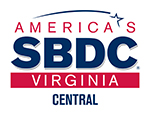
This website is provided by the Central Virginia SBDC thanks to GO VIRGINIA and regional sponsors. CVSBDC is hosted by Community Investment Collaborative and funded in part through a cooperative agreement with the U.S. Small Business Administration, George Mason University and GO VIRGINIA, a state-funded initiative administered by the Virginia Department of Housing and Community Development (DHCD).
©2022 Yes! We Rise
